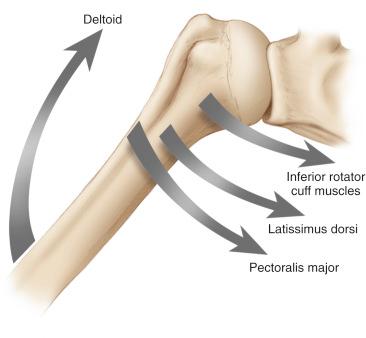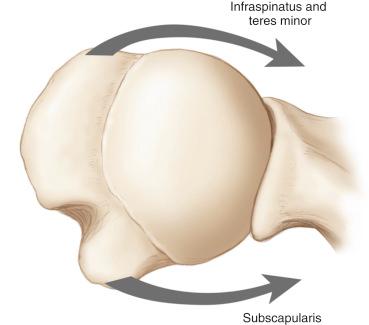Physical Address
304 North Cardinal St.
Dorchester Center, MA 02124
The shoulder is a complex anatomic structure due to its multiple passive and active structures working together for stability and joint motion. The shoulder’s ability for multiple degrees of motion is based on the interaction of multiple structures that react to mechanical stimuli and adjust accordingly. The rotator cuff, a group of muscles surrounding the glenohumeral joint, not only acts as a dynamic stabilizer further supporting static stabilizing structures but also adds to the passive stability of the shoulder by bulk and barrier effects due to their location and orientation around the glenohumeral joint. It also helps provide concavity compression and the torque needed for motion in multiple planes. The biomechanics of the shoulder are intimately associated with the rotator cuff, as altered biomechanics are often the result of rotator cuff pathology and vice versa. Rotator cuff tears often result in loss of function, strength, and stability. In this chapter, the biomechanics and clinical function of the rotator cuff and rotator cuff pathology are discussed in depth.
The shoulder has the greatest range of motion of any joint in the human body and has six degrees of freedom of motion (anterior-posterior/superior-inferior/medial-lateral translation and flexion-extension/external-internal rotation/abduction-adduction). Due to this large range of motion, however, it is predisposed to instability. There are both static and dynamic stabilizing mechanisms in the shoulder, including soft tissue, bony geometry, and shoulder muscles. The rotator cuff muscles help provide shoulder function and act as a stabilizer in both passive and active states.
The subscapularis muscle provides a barrier to resist anterior dislocation of the humeral head. Early studies of shoulder stabilization involved sectioning of various anatomic components in cadavers. At 0 degrees of abduction, the subscapularis muscle plays the primary stabilizing role; at 45 degrees of abduction, the subscapularis, middle glenohumeral ligament, and a portion of the inferior glenohumeral ligament provide stability; and nearing 90 degrees of abduction, the inferior glenohumeral ligament prevents dislocation. Biomechanical studies also offer additional information regarding directional stability. The long head of the biceps tendon (LHBT) provides more than 30 N of anterior stabilization in neutral rotation, with the subscapularis providing the majority of the stabilization in external rotation. Ligaments play a bigger role in stability, as they become loaded at higher displacements. The supraspinatus and biceps muscles are important active stabilizers in inferior stabilization, with the inferior glenohumeral ligament passively stabilizing in external rotation. Posterior stability is also provided by passive muscle tension of the rotator cuff. A cadaveric study by Ovesen et al. demonstrated that both the supraspinatus and infraspinatus/teres minor were important in stabilizing the shoulder posteriorly. Posteriorly, the subscapularis muscle resists subluxation, with the coracohumeral (CH) ligament contributing in neutral rotation. Release of the coracoacromial (CA) ligament to treat impingement causes glenohumeral laxity both anteriorly and inferiorly, indicating its importance as a static restraint.
Intricate coordination and anatomical positioning of the rotator cuff muscles and the LHBT creates an ideal configuration to actively compress the humeral head into the cavity of the glenoid. Shoulder anatomy also provides the rotator cuff muscles with short lever arms, establishing a stable and dynamic fulcrum during abduction.
Many biomechanical studies have been performed to try and elucidate the role of the rotator cuff in glenohumeral motion. The subscapularis has been shown to internally rotate and adduct the humerus. The supraspinatus is known as a shoulder abductor, but its role in humeral rotation is dependent on the initial position of the humerus. The supraspinatus muscles are external rotators during abduction and internal rotators during flexion. A study by Gates et al. characterized the effect of the anterior and posterior subregions of the supraspinatus on humeral rotation. Using different angles of glenohumeral abduction and differential loading of the anterior and posterior subregions, the authors concluded that in the scapular plane, the anterior subregion of the supraspinatus acts as both an internal and external rotator depending on the initial humeral position. On the other hand, the posterior subregion acts only as an external rotator. The infraspinatus and teres minor work as humeral external rotators and are most active with the humerus adducted.
Force couples occur when two opposing muscle groups create a given moment around a fulcrum. The rotator cuff creates a force couple around the glenohumeral joint, with coordinated activation and inactivation of agonist and antagonist muscles. Two major force couples act synergistically on the glenohumeral joint: one in the coronal plane and the other in the transverse plane.
Inman et al. first described the force couple acting in the coronal plane between the deltoid and inferior rotator cuff (infraspinatus, teres minor, and subscapularis) ( Fig. 3.1 ). The deltoid moment lies above the center of rotation, while the inferior cuff moment acts parallel to the lateral border of the scapular below the center of rotation. This force couple is important in producing stable glenohumeral abduction. More recently, the pectoralis major and latissimus dorsi have been included in this force couple. The depressor moment produced by the inferior rotator cuff may be too weak to counterbalance the strong deltoid moment. However, the pectoralis major and latissimus dorsi have similar depressor moments as the deltoid and therefore are now thought to work along with the inferior rotator cuff in the coronal plane force couple. Recent biomechanics studies have replicated the moments produced by the pectoralis major and latissimus dorsi to create a more anatomic shoulder construct.

The transverse force couple comprises moments produced by the subscapularis anteriorly and infraspinatus and teres minor posteriorly ( Fig. 3.2 ). Cadaver studies determined that glenohumeral joint motion is not affected as long as this force balance is intact. Quantitative analysis confirmed that the direction and magnitude of joint reaction forces were most affected by the integrity of the anterior-posterior force balance, with no significant change after incomplete or complete tear of the supraspinatus tendon. This dynamic relationship is an important aspect of understanding normal shoulder motion and how a disrupted force balance can play a role in shoulder pathologies. Inability to maintain a balanced transverse force couple can lead to anterior or posterior translation of the humeral head. For example, in the setting of a massive rotator cuff tear involving the infraspinatus and teres minor (or posterior moment), the larger moment produced by the subscapularis can lead to anterior translation of the humeral head. This uncoupling between forces leads to an unstable fulcrum for glenohumeral motion.

A cadaveric study by Mihata et al. investigated the effects of a simulated weakened subscapularis as seen in overhand throwers on glenohumeral kinematics and contact pressures. In their model, they used a custom shoulder testing system that replicated multiple lines of pull for the rotator cuff, deltoid, pectoralis major, and latissimus dorsi. Therefore the authors used all muscles in the transverse and coronal force couples. They found that less force on the subscapularis lead to a significant increase in external rotation and posterosuperior glenohumeral contact pressure. This is likely due to the disrupted transverse force couple leading to an imbalance between anterior and posterior forces. The strong moment arm of the infraspinatus, usually restrained by the subscapularis, now has a stronger moment arm relative to the subscapularis moment arm on the humerus leading to posterosuperior translation. These results give insight to the pathophysiology behind internal impingement and partial-thickness articular-sided rotator cuff tears seen in throwing athletes.
Become a Clinical Tree membership for Full access and enjoy Unlimited articles
If you are a member. Log in here